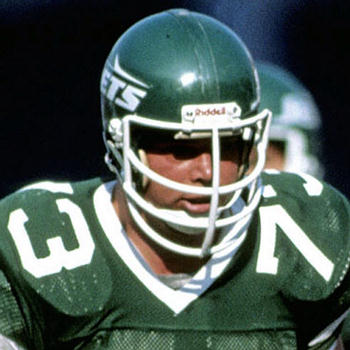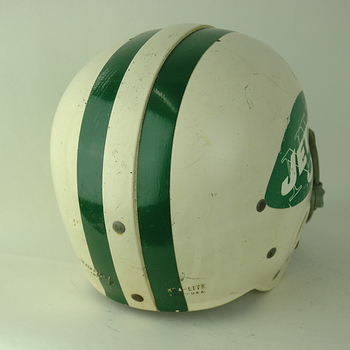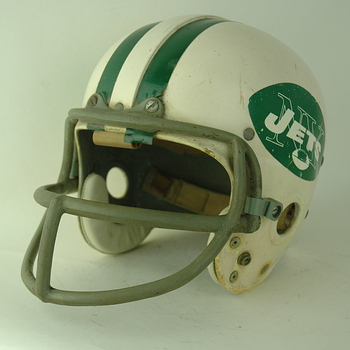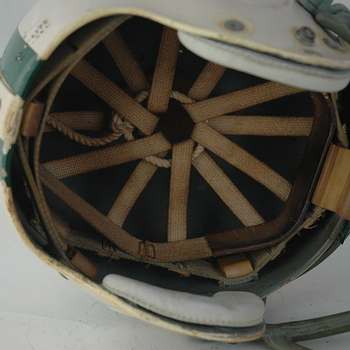The
HELMET HUT
staff includes residents of the
New York City metropolitan area, thus, we are aware that by the mid-point of
most seasons, the frustration of most Jets fans is palpable. There have been
a number of all-time great players including Pro Football Hall Of Fame
honorees Joe Namath, Don Maynard, Curtis Martin, and coach Weeb Ewbank, and
a few additional players like John Riggins who made their true Hall of Fame
impact with other teams, but the franchise history is one of abject
disappointment. To many long suffering fans, the lone Super Bowl winning
season of 1968 is considered to be an “era” in and of itself. Adding to the
frustration level is the belief that there is one New York Jets player who
did not gain entry to the Hall Of Fame but should have, an All Pro at three
different positions, and a singular object of Jet fan admiration and joy.
This is of course, defensive lineman Joe Klecko.
In every poll,
survey, or relevant television show about the organization, only Klecko has
been deemed worthy of mention when discussing Jets uniform number 73. His
illustrious professional career, spanning eleven years with the Jets and a
finale with the Colts, is one of the few long term highlights of Jets
history. Significantly, only one player wore Klecko’s number after he left
the Jets, offensive tackle David Williams who played the first seven of his
nine years with the Oilers and ’96 and ’97 in New York. On December 26,
2004, Joe Klecko was honored with the retirement of his jersey number which
will now obviate its appointment to future players. While a number of
players donned that uniform number prior to Klecko, it had an eight year
hiatus from use before being assigned to Big Joe in 1977.
While all aspects of uniform
presentation interests our staff, we are of course, most focused on helmets
and on occasion, the staff at
HELMET HUT
is graced with a helmet that is
received as a gift or merely shown to us for comment or evaluation. As
“helmet nuts” in every positive sense of the term, excitement is stimulated,
examination is performed, and research commences. Despite tremendous pride
that goes into our work, great effort, conversations or written exchanges
with former players and/or team personnel, the exact origin or original user
of any specific helmet may remain unconfirmed. Thus it is with a beautifully
preserved New York Jets Riddell RK helmet, manufactured in the mid-1960s and
last reconditioned in 1970 or 1971. As was often the case, a strip of tape
that was labeled with a player’s name had been removed at an earlier date
but there is a clearly written number 73 on the inside of the shell. What
appears to be a team inventory number, T-869 has been handwritten high in
the crown of the shell and there are obvious signs of game wear and use. The
well preserved OPO butterfly clip mask presents a beautiful contrast to a
helmet that was clearly worn by one of the iconic Joe Namath’s teammates. Of
course, this helmet and mask were in use long before Joe Klecko joined the
Jets as a sixth round draft pick in 1977. Our staff research proved to be an
interesting and winding road through a Jets history that highlighted very
talented players who for the most part, just fell short of fulfilling what
might have been impressive professional careers. Although a grouping of
relatively unheralded players donned this shell, we found a talented “group
of 73s” and we gave consideration to all as possible owners of this classic
Riddell piece of history.
The Jets were
bound and determined to protect their newly drafted and projected super star
quarterback Joe Namath entering the 1965 season, and thus stocked training
camp with many offensive linemen. One was actually a converted receiver,
Wisconsin’s Ralph Farmer. He entered the University of Wisconsin as a
heralded 215 pound pass catching end but had been moved to tight end as his
senior season weight moved over the 230 mark. The Jets drafted him with
every intention of playing him as an offensive tackle, gave him number 73 at
the start of camp, but he was cut and wound up with the Continental Football
League’s Philadelphia Bulldogs and later was a teacher before going into
business.
Another
undrafted free agent, one with a few years of minor league experience coming
into the Jets ‘65 camp and the pride of Derby, Connecticut and Southern
Connecticut State University, was Nick DeFelice. An All State performer for
the Derby Red Raiders, he began his collegiate career at the University of
Miami but transferred home to SCSU where he became the first in school
history to play National Football League football. He was the star of the
team for three varsity seasons, captain of the 1960 squad, and both an All
New England and Little All American honoree as a 6’3”, 230 pound tackle.
Considered small for a pro tackle, he taught locally and played for the
minor league Ansonia Black Knights of the Atlantic Coast Football League in
1962 and ’63. Filling out to a full 255 pounds and honing his skills as an
ACFL All Star with the Hartford Charter Oaks, DeFelice made the New York
Jets roster for the 1965 season, was an integral part of special teams
appearing in all fourteen games, and had the opportunity to fall on and
cover the football on a kickoff return.
Also in the
Jets 1965 training camp was former Xavier University tackle Mitchell Dudek,
who at 6’4” and 255 pounds, was the Musketeers rock during his college
career in Cincinnati. The Evansville, Illinois native who had been a
standout at St. George High School was the Jets 19th round draft
pick and shuffled to guard during training camp. Dudek was handed jersey
number 70 but missed the opportunity to show it off during the regular
season as the Jets sent him to their Jersey Jets minor league affiliate in
the Atlantic Coast Football League where he helped an exceptional offense
lead the league with 412 points scored, double that of most of the league’s
teams, and a 12 – 2 record.
When the Jets
opened camp for the ’66 season, Dudek was back having gained five to ten
pounds of muscle, and again was wearing number 70. Assigned number 73 for
the ’65 season, DeFelice was also brought in for a return engagement but
lost his number and was assigned number 71 with 73 being given to Indiana
rookie Ken Hollister. Hollister, originally from Columbus, Ohio where he was
a key member of an Eastmoor High School team that is still considered to be
one of the greatest in central Ohio history, had been a mainstay tackle
specializing on defense for the Hoosiers and was a twelfth round draft
choice of both the Jets and NFL Falcons. Both teams also projected him as a
defensive end. He had worn number 70 in college, but his number assignment
with the Jets in ’66 became moot when he was signed by the Jets ACFL Jersey
Jets farm team for the season where he would have the opportunity to apply
his existing skills to his new responsibilities as a full time offensive
tackle.
DeFelice,
practicing but not playing the first two weeks of the season, was then
traded to the expansion Miami Dolphins who decided he needed a bit more
minor league play. Declining the opportunity to participate for the Orlando
Panthers of the Continental Football League, and a bit frustrated with his
role as a back-up performer, he returned to Connecticut and signed with the
Hartford Knights, also of the Continental League. DeFelice built a
tremendous reputation in the minor league ranks and was arguably the
consistently best offensive linemen in the Atlantic Coast Football League
when he helped the Knights dominate the league in ’68 and 1969. He was again
All ACFL in 1970, his final season of organized football and he settled into
a life of becoming an exceptionally successful businessman while finding
time to coach at both the high school and community college levels. Dudek
was given number 73 for the 1966 regular season and very much as DeFelice
had done the season before, he appeared in every game, primarily in special
teams and back-up roles as an offensive guard.
Hollister was
brought back to the N.Y. Jets camp for the 1967 season as was Dudek who had
decided to give pro ball one more shot while still wearing the number 73 he
so proudly wore in ’66. Both were released and like many graduates of both
the University of Cincinnati and Xavier, Dudek returned to his alma mater
and completed a Masters Degree in Educational Administration and went to
work for local giant Proctor And Gamble as a sales representative. He
remained in management, serving as sales and/or marketing director for a
number of companies while raising a family in his native Illinois. Another
member of the Jets training camp class was the highly touted third round
draft choice Dennis “Stretch” Randall, a skilled 6’7”, 250 pound defensive
end who had starred at both Tulsa’s McLain High School and Oklahoma State
University where he was a First Team All Big Eight selection. Before the
season began, with Dudek gone, Randall took over number 73 and he kept it
into ‘68’s training camp. Although the newly minted Cincinnati Bengals chose
five Jets in the pre-season expansion draft, Randall was not one of them but
was on the Bengals roster by opening day where he won a starting position at
defensive end during the season, causing incumbent Willie Lee Jones to
briefly quit the squad.
The 1968 Jets
rookie roster included Raymond Hayes, a multi-sport standout at Clawson
(Michigan) High School whose football offers were limited only because of a
broken hand he suffered during his senior season. He flourished at Toledo as
part of the ’67 team that reeled off nine consecutive victories and became
the twelfth round draft pick of the Jets after being named second team All
Mid America Conference defensive tackle in 1966 and first team in ’67 when
he also received a number of Honorable Mention All American nods. Hayes at
6’5” and 248 pounds was exceptionally competitive. He began the exhibition
game season wearing number 76 and was given Randall’s number 73 when the
latter departed for the Bengals, and then saw action in six season games.
When the Jets won Super Bowl III at the conclusion of the 1968 season,
Hayes, fellow defensive lineman Karl Henke, linebacker Mike Stromberg, and
running back Billy Joe were not activated for the game but deservedly shared
in the glory, a full play-off share, and a Super Bowl ring. Hayes retained
his number 73 when returning to camp for the 1969, ’70, and ’71 seasons but
only saw active game play in ’68. He returned to his native Michigan where
he built a successful real estate business.
The history of
the New York Jets number 73 and the beautiful Riddell RK helmet that went
with it would be a fait accompli if not for the official New York Jets Super
Bowl III team photograph. In it, the man assigned the number for 1968, the
aforementioned Raymond Hayes, is seen in the back row, his 6’5” physique
draped in number 89, a numeral that was not used in active play during the
season. Also previously noted was Ray’s inactivation for the Super Bowl game
but the photo does feature a number 73, the former Kansas City Chiefs
offensive lineman Tony “Biggie” DiMidio. A center and guard out of
Pennsylvania’s West Chester State College, he was drafted in 1964 by both
the Giants and Chiefs and decided to sign with the longer established
league. He was given a spot on the defensive line where even at 6’4” and 260
pounds, he admittedly had difficulty adjusting to NFL competition. He was
progressing and was well regarded by the staff but a knee injury against the
Redskins, mid-season surgery, and post-surgical rehabilitation put him on
the shelf for a solid year. He returned to the Giants for 1965’s training
camp but was greeted by new coaches after the Giants toxic ’64 season, and
was released. He negotiated a contract with the Jets in an attempt to remain
close to his Pennsylvania home, but the Chiefs exercised their rights to him
and he played the entire 1965 season as a member of their taxi squad. 1966
was more rewarding as he was the back-up for Jim Tyrer, the eight-time All
AFL All Pro selection and the All Time All AFL offensive guard and was a
member of the Chiefs Super Bowl I team. He again fulfilled his back-up role
in 1967 but failed to make the team in 1968 when highly touted Texas A&M
guard Mo Moorman was brought into camp. DiMidio returned to Pennsylvania to
begin his lengthy career as a Health and Physical Education teacher and
coach in the Philadelphia School District but there stands the photographic
proof that he was considered to be a member of the Jets Super Bowl III
squad. There is no record and no mention of DiMidio’s participation with the
Jets in any official NFL record keeping but until 1977 and the arrival of
Joe Klecko, he and Ray Hayes are the last Jets to have worn number 73 and
perhaps, our featured helmet.





